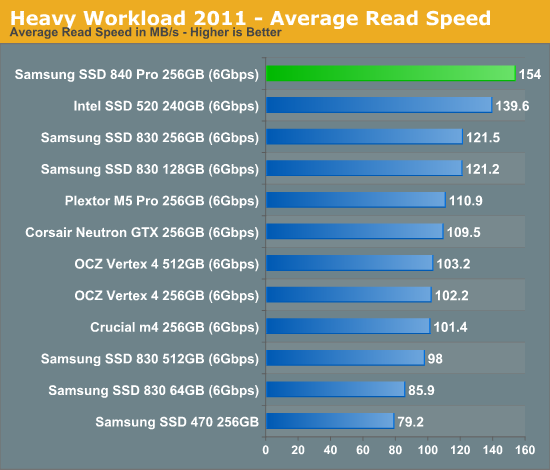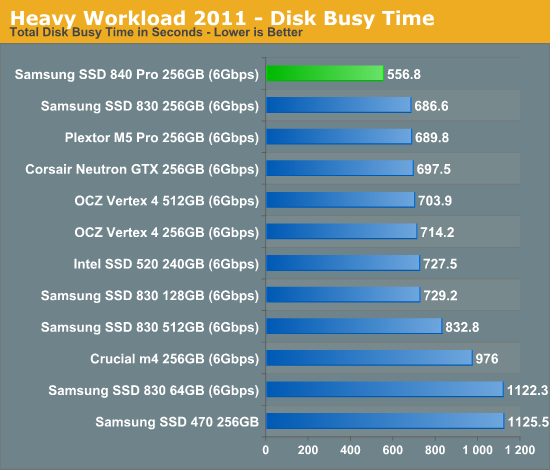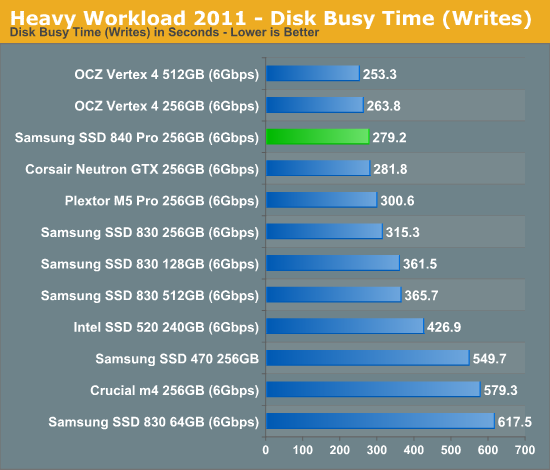Samsung SSD 840 Pro (256GB) Review
by Anand Lal Shimpi on September 24, 2012 7:00 AM EST- Posted in
- Storage
- SSDs
- Samsung
- Samsung SSD 840
AnandTech Storage Bench 2011
Two years ago we introduced our AnandTech Storage Bench, a suite of benchmarks that took traces of real OS/application usage and played them back in a repeatable manner. I assembled the traces myself out of frustration with the majority of what we have today in terms of SSD benchmarks.
Although the AnandTech Storage Bench tests did a good job of characterizing SSD performance, they weren't stressful enough. All of the tests performed less than 10GB of reads/writes and typically involved only 4GB of writes specifically. That's not even enough exceed the spare area on most SSDs. Most canned SSD benchmarks don't even come close to writing a single gigabyte of data, but that doesn't mean that simply writing 4GB is acceptable.
Originally I kept the benchmarks short enough that they wouldn't be a burden to run (~30 minutes) but long enough that they were representative of what a power user might do with their system.
Not too long ago I tweeted that I had created what I referred to as the Mother of All SSD Benchmarks (MOASB). Rather than only writing 4GB of data to the drive, this benchmark writes 106.32GB. It's the load you'd put on a drive after nearly two weeks of constant usage. And it takes a *long* time to run.
1) The MOASB, officially called AnandTech Storage Bench 2011 - Heavy Workload, mainly focuses on the times when your I/O activity is the highest. There is a lot of downloading and application installing that happens during the course of this test. My thinking was that it's during application installs, file copies, downloading and multitasking with all of this that you can really notice performance differences between drives.
2) I tried to cover as many bases as possible with the software I incorporated into this test. There's a lot of photo editing in Photoshop, HTML editing in Dreamweaver, web browsing, game playing/level loading (Starcraft II & WoW are both a part of the test) as well as general use stuff (application installing, virus scanning). I included a large amount of email downloading, document creation and editing as well. To top it all off I even use Visual Studio 2008 to build Chromium during the test.
The test has 2,168,893 read operations and 1,783,447 write operations. The IO breakdown is as follows:
| AnandTech Storage Bench 2011 - Heavy Workload IO Breakdown | ||||
| IO Size | % of Total | |||
| 4KB | 28% | |||
| 16KB | 10% | |||
| 32KB | 10% | |||
| 64KB | 4% | |||
Only 42% of all operations are sequential, the rest range from pseudo to fully random (with most falling in the pseudo-random category). Average queue depth is 4.625 IOs, with 59% of operations taking place in an IO queue of 1.
Many of you have asked for a better way to really characterize performance. Simply looking at IOPS doesn't really say much. As a result I'm going to be presenting Storage Bench 2011 data in a slightly different way. We'll have performance represented as Average MB/s, with higher numbers being better. At the same time I'll be reporting how long the SSD was busy while running this test. These disk busy graphs will show you exactly how much time was shaved off by using a faster drive vs. a slower one during the course of this test. Finally, I will also break out performance into reads, writes and combined. The reason I do this is to help balance out the fact that this test is unusually write intensive, which can often hide the benefits of a drive with good read performance.
There's also a new light workload for 2011. This is a far more reasonable, typical every day use case benchmark. Lots of web browsing, photo editing (but with a greater focus on photo consumption), video playback as well as some application installs and gaming. This test isn't nearly as write intensive as the MOASB but it's still multiple times more write intensive than what we were running in 2010.
As always I don't believe that these two benchmarks alone are enough to characterize the performance of a drive, but hopefully along with the rest of our tests they will help provide a better idea.
The testbed for Storage Bench 2011 has changed as well. We're now using a Sandy Bridge platform with full 6Gbps support for these tests.
AnandTech Storage Bench 2011 - Heavy Workload
We'll start out by looking at average data rate throughout our new heavy workload test:

A strong showing in all of our low level IO tests, with no drawbacks, results in 24% better performance than the 830 in our heavy workload. There's simply no faster drive than the 840 Pro.


The next three charts just represent the same data, but in a different manner. Instead of looking at average data rate, we're looking at how long the disk was busy for during this entire test. Note that disk busy time excludes any and all idles, this is just how long the SSD was busy doing something:













96 Comments
View All Comments
iwod - Tuesday, September 25, 2012 - link
True but i think there will be a bottleneck somewhere else once we hit certain number of Random Read. Anand already has results that any more then 40~50MB/s random wrote give us any more benefits. I think it would be similar for Random Read as well although we have so far not reach that point yet.Of coz these results are with today's software. Things could be different again when we reach that limit.
leboon - Monday, September 24, 2012 - link
Thanks for the review. I must say that the random comments interspersed throughout the article about the regular 840--which isn't even being reviewed-- seemed rather strange and out of place.On topic though, this new Samsung drive looks very promising and I'm looking forward to grabbing one of them when they're released, to breathe new life into an aging laptop.
Kristian Vättö - Monday, September 24, 2012 - link
That's because we didn't get any information about the regular 840 until a few hours before the NDA was lifted, but at least I feel like it was still important to note that such drive exists.There will be a review ASAP though. I just came back to my hotel room and found a gift box with a 250GB 840 in it :-)
nathanddrews - Monday, September 24, 2012 - link
"Joy!"-Stimpy
Grok42 - Monday, September 24, 2012 - link
Quit yammering and get to testing and writing! I'm guessing that is the 840 non-pro? Never mind, don't answer that, just focus.dishayu - Monday, September 24, 2012 - link
Active power : 0.068WSurely this has to be a mistake? I can't imagine any drive today with such low active power today.
DanNeely - Monday, September 24, 2012 - link
I'd like to know what Samsung's measuring for that number too; Anand measured the 840 pro an order of magnitude higher during write operations. Unless that number is just for the controller and not for the flash too there's something not right about the gap between that number and what AT's measuring.iwod - Monday, September 24, 2012 - link
I think that is only the controller. You have to include the LP-DDR2 as well.Its Working power is still higher then Intel. Although i dont like sammy, i hope the final product will be even better then this.
LGrill - Monday, September 24, 2012 - link
I was thinking the same thing.ssj3gohan - Monday, September 24, 2012 - link
This is completely correct. Anandtech and basically every other review site out there measures power consumption wrong: they measure it while *not* booted into an OS that supports SATA power management. With DIPM (device initiated power management) enabled, the drive should hit this power consumption easily.Same goes for pretty much every other SATA SSD these days. They're all well below 0.3W idle except for Sandforce drives. For instance, all Intel drives (intel- and marvell-based) are about 75 to 100mW idle.